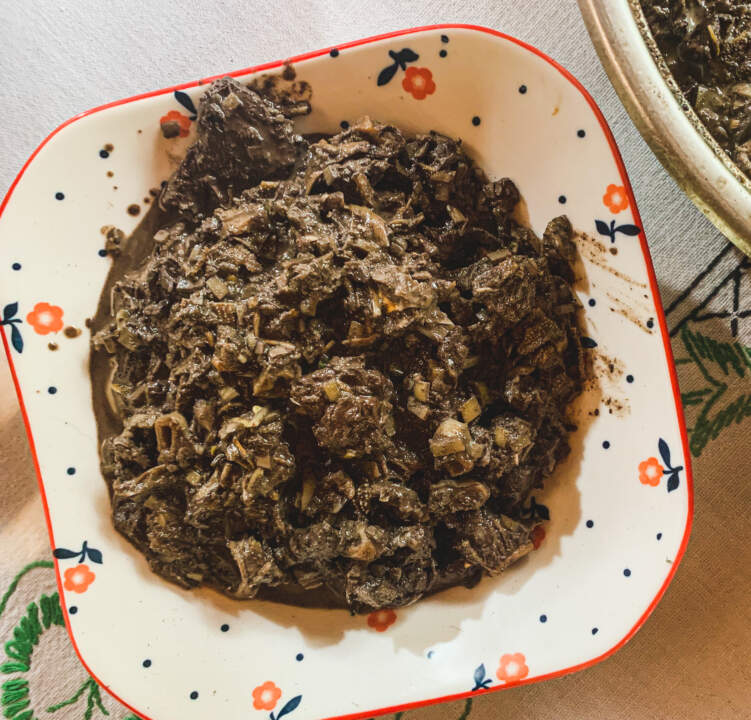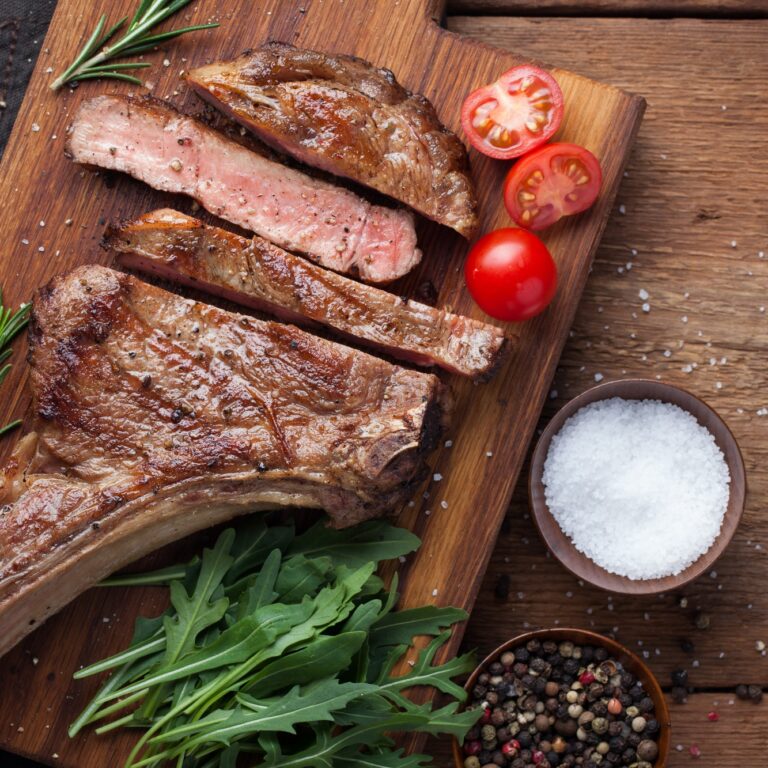

It’s incidentally Valentine’s Day and this happened to be in the menu. (Oh ha, disclaimer agad agad). Anyway, KariKari was on the menu today. Kari kari is a traditional dish from the province of Marinduque where I am currently living in since the pandemic. This hearty dish is made from a combination of banana blossoms, pigs’ innards, and pigs’ blood, which are simmered together with coconut milk until tender.
Why is it called Kari Kari though?
Island visitors are often confused when offered this dish, expecting Kare Kare which is a Tagalog peanut stew. The origins of Kare Kare and Kari Kari can be traced back to the pre-colonial era of the Philippines, where they were already popular dishes among the original inhabitants of the islands.
Kare Kare, in particular, has been linked to the cooking techniques and ingredients used by the Moro people of the southern Philippines, who were known for using peanuts and coconut milk in their dishes. The dish was later adapted by the Kapampangan, who added their own unique spin on it by using a variety of meats and vegetables, such as oxtail and eggplants. Over time, Kare Kare became a staple in Filipino cuisine and is now considered one of the foremost national dish of the Philippines.
As for Kari Kari, I am claiming it for the province of Marinduque, (Sorry, no reference there) where it is a traditional dish that is commonly served during fiestas and special occasions. While the exact origins of Kari Kari are not well documented, I would hazard a guess that it is a product of the ingenuity and resourcefulness of Filipino cooking, where we made use of all available ingredients to create a delicious and satisfying meal.
According to historians though, it is unlikely that Kari Kari and Kare Kare are derived from the Indian dish curry, as they have distinct flavors and ingredients that are unique to Filipino cuisine. However, it is possible that the use of peanuts and coconut milk in Kare Kare was influenced by Indian cooking techniques, as peanuts and coconut are commonly used in Indian cuisine as well. This is still much debated but I’ll leave you to that as I’ll now focus on the Marinduque KariKari
What is Kari Kari
Beyond the name, people’s initial reaction to the dish is that it is Dinuguan, another offal dish enjoyed by Filipinos. Dinuguan is a traditional dish sometimes also called as “chocolate meat” in jest because of its dark color. It is a savory stew that is made with pork meat and/or offal, such as intestines and liver (such as the ones used in Bopis), that are simmered in a rich and flavorful sauce made from pig’s blood, vinegar, and spices. If one is looking for a way to figure out the difference of Dinuguan and Kari Kari, it would be the level of spice added as Kari Kari is always spicy.
The Kari Kari dish also has a distinctive dark color, which also comes from the addition of pig’s blood, but unlike Dinuguan, it doesn’t have a thick sauce and is dry instead with bits and pieces of curdled blood.
The pigs’ innards are another important component of kari kari. These can include the heart, liver, lungs, and other organs, (called menudencias when buying them from the market) which are cleaned and boiled until tender. The resulting broth from boiling the innards is used as the base for the stew, providing a rich and savory flavor.
The banana blossoms, or “puso ng saving” (hence the Valentines reference) in Tagalog, are an essential ingredient in kari kari. They are the immature flower of the banana tree and have a unique texture and flavor that adds depth and complexity to the dish. The blossoms are thinly sliced and boiled in water with a bit of salt to remove any bitterness before being added to the stew. The restaurant versions doesn’t have this ingredient as its considered to be an extender of the dish.
Finally, the coconut milk is added to the stew, which gives the dish its distinctive creamy taste. The coconut milk (gata) is often allowed to simmer with the blood until the dish is almost dry, giving it a rich and earthy taste. If you’re in Manila or a city where it’s hard to get fresh “gata”. you can use Coco Mama Gata or a canned one. Use the first press or the so-called coconut cream version.
Kari kari is typically served with a side of steamed rice. The dish is often enjoyed during special occasions and celebrations, such as weddings, fiestas, and other gatherings. (As an aside aside, you will probably not get to taste it at weddings as the kari kari is considered to be a cook’s privilege -to be enjoyed as pulutan while the cooks are preparing the food. )
While kari kari may not be for everyone due to its unconventional ingredients, it is a beloved dish in Marinduque. It is a nod to the creativity and resourcefulness of Filipino cuisine, which has a long history of making delicious meals out of humble and often overlooked ingredients.
If you ever have the chance to try our kari kari, don’t hesitate to give it a try. It is a unique and flavorful dish that is sure to leave a lasting impression.
Ingredients
Shopping List:
- 1 kilo Menudencias (pigs heart, spleen, kidney, small intestine) / **Alternative is lean ground pork**
- 1 banana blossoms (optional)
- 5-10 bird's eye chili (sliced)
Pantry Items:
- 2 tbsp vegetable oil
- half a head garlic
- 1 big onion -sliced
- 1 red bell pepper (julienned) (optional)
- 2 tbsp soy sauce
- 2 tbsp liquid seasoning
- 1 can coconut milk
- 1 tsp sugar
- 3 tbsp vinegar
- a few dry laurel leaves
- salt
Tools Needed:
- Knife (for slicing and chopping)
- Cutting board
- Pot or saucepan (for cooking)
- Slotted spoon (for removing solids after cooking)
- Bowl or plate (for serving)
Instructions
PREPARATION
- Clean menudencia by rubbing salt on the meats and washing with running water. This is a very important part of getting rid of the funky smell.
- Boil innards with salt for 10 minutes. Discard water and rinse boiled meats with running water.
- Drain and chop into very small pieces. Set aside.
Preparing the banana blossoms
- Clean the banana blossoms and slice thinly
- Boil water with a 1 tbsp of salt. Add banana blossoms and let boil for about 10 minutes.
- Squeeze out water to remove any bitterness. Set aside.
Cooking
- Saute onion and garlic. Add bell pepper.
- Add meat and saute until brown.
- Add vinegar and cook until vinegar is almost evaporated.
- Add banana blossoms if using.
- Season (chili, soy sauce. liquid seasoning, sugar)
- Add pigs blood. Simmer.
- Add coconut milk. Let cook until almost dry.
- Serve with rice!
Notes
In case there is no available offal, you can use ground lean meat.
Tips: For deeper flavor, brown pork innards first before long simmer. Add extra chilies for heat.
Variations: Replace banana blossom with green papaya or string beans. Use chicken instead of pork.
Pair with: Bona fide rice cakes, or Puto for a satisfying meal. Goes well with tropical fruits as post-meal snack.
Leftovers: Refrigerate for up to 5 days. Or freeze in portions for up to 3 months. Reheat on the stovetop while stirring.





